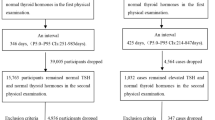Abstract
Postprandial lipoprotein metabolism is suggested to play a role in the pathogenesis of atherosclerosis. In this study, we investigated postprandial lipemia and its relationship to cardiovascular risk factors in patients with overt and subclinical hypothyroidism. Twentynine female patients with TSH levels greater than 5 μIU/mL and 12 euthyroid control female subjects were included in the study. Fifteen patients had subclinical hypothyroidism and 14 had overt hypothyroidism. All subjects underwent an oral lipid tolerance test. If triglyceride levels increased by 80% or more, subjects were considered postprandial lipemia positive. Control, overt hypothyroid, and subclinical hypothyroid groups were not statistically different with respect to anthropometric measurements, fasting blood C-reactive protein, uric acid, homocysteine, glucose, insulin, lipoprotein (a), apolipoprotein B levels, and homeostasis model assessment index. Fasting triglyceride levels correlated positively with TSH levels. Postprandial lipemia frequency was higher in overt hypothyroid subjects than in the control group. The subclinical hypothyroid group did not differ from the hypothyroid group with respect to postprandial lipemia frequency. In subjects with TSH levels higher than 5 μIU/mL, PPL risk was increased sevenfold. The results of this study show that postprandial triglyceride metabolism is affected in hypothyroidism.
Similar content being viewed by others
References
Kreisberg, R. A. and Oberman, A. (2002). J. Clin. Endocrinol. Metab. 87, 423–437.
Stone, N. J., Bilek, S., and Rosenbaum, S. (2005). Am. J. Cardiol. 96, 53E-59E.
Hokanson, J. E. and Austin, M. A. (1996). J. Cardiovasc. Risk 3, 213–219.
Manninen, V., Tenkanen, L., Koskinen, P., et al. (1992). Circulation 85, 37–45.
Jeppesen, J., Hein, H. O., Suadicani, P., and Gynteiberg, F. (1998). Circulation 97, 1029–1036.
Zilversmit, D. B. (1979). Circulation 60, 473–485.
Cohn, J. S., McNamara, J. R., Krasinski, S. D., Russell, R. M., and Schaefer, E. J. (1989). Metabolsim 38, 484–490.
Nicholls, S. and Lundman, P. (2004). Semin. Vasc. Med. 4, 187–195.
Vigna, G. B., Delli Gatti, C., and Fellin, R. (2004). Nutr. Metab. Cardivasc. Dis. 14, 121–127.
Cappola, A. R. and Ladenson, P. W. (2003). J. Clin. Endocrinol. Metab. 88, 2438–2444.
Duntas, L. H. (2002). Thyroid 12, 287–293.
Martinez-Triguero, M. L., Hernandez-Mijares, A., Nguyen, T. T., et al. (1998). Mayo Clin. Proc. 73, 837–841.
Danese, M. D., Ladenson, P. W., Meinert, C. L., and Powe, N. R. (2000). J. Clin. Endocrinol. Metab. 85, 2993–3001.
Caraccio, N., Ferrannini, E., and Monzani, F. (2002). J. Clin. Endocrinol. Metab. 87, 1533–1538.
Palmieri, E. A., Fazio, S., Lombardi, G., and Biondi, B. (2004). Treat. Endocrinol. 3, 233–244.
Ladenson, P. W. (1990). Am. J. Med. 88, 638–641.
Steinberg, A. D. (1968). Ann. Intern. Med. 68, 338–344.
Nedrebo, B. G., Ericsson, U. B., Nygard, O., et al. (1998). Metabolism 47, 89–93.
Ozcan, O., Cakir, E., Yaman, H., et al. (2005). Clin. Endocrinol. 63, 203–206.
Hueston, W. J., King, D. E., and Geesey, M. E. (2005). Clin. Endocrinol. 63, 582–587.
Lithell, H., Boberg, J., Hellsing, K., et al. (1981). European Eur. J. Clin. Invest. 11, 3–10.
de Bruin, T. W., van Barlingen, H., van Linde-Sibenius, Trip, M., et al. (1993). J. Clin. Endocrinol. Metab. 76, 121–126.
Hokanson, J. E. and Austin, M. A. (1996). J. Cardiovasc. Risk 3, 213–219.
Netsel, P. J. (1964). J. Clin. Invest. 43, 943–949.
Cohn, J. S., McNamara, J. R., and Schaefer, E. J. (1988). Clin. Chem. 34, 2456–2459.
Cohn, J. S., Johnson, E. J., Millar, J. S., et al. (1993). J. Lipid. Res. 34, 2033–2040.
Weintraub, M., Grosskopf, I., Trostanesky, Y., Charach, G., Rubinstein, A., and Stern, N. (1999). J. Clin. Endocrinol. Metab. 84, 2532–2536.
Karamanos, B. G., Thanopoulou, A. C., and Roussi-Penesi, D. P. (2001). Diabet. Med. 18, 32–39.
Author information
Authors and Affiliations
Corresponding author
Rights and permissions
About this article
Cite this article
Tanaci, N., Ertugrul, D.T., Sahin, M. et al. Postprandial lipemia as a risk factor for cardiovascular disease in patients with hypothyroidism. Endocr 29, 451–456 (2006). https://doi.org/10.1385/ENDO:29:3:451
Received:
Revised:
Accepted:
Issue Date:
DOI: https://doi.org/10.1385/ENDO:29:3:451




